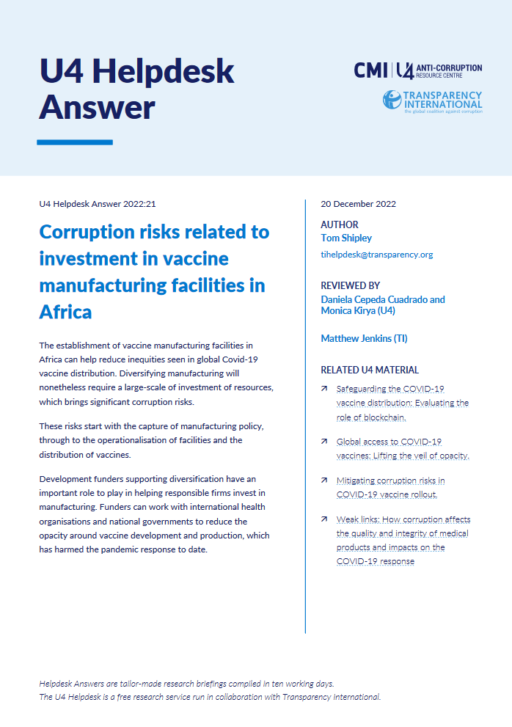- Home
- Anti-Corruption Helpdesk
- Corruption risks related to investment in vaccine manufacturing facilities in Africa
Corruption risks related to investment in vaccine manufacturing facilities in Africa

This Anti-Corruption Helpdesk brief was produced in response to a query from a U4 Partner Agency. The U4 Helpdesk is operated by Transparency International in collaboration with the U4 Anti-Corruption Resource Centre based at the Chr. Michelsen Institute.
Query
Please provide an overview of the corruption risks associated with investment in new vaccine facilities in Africa, with a focus on Egypt, Morocco, Senegal and South Africa.
Summary
The establishment of vaccine manufacturing facilities in Africa can help reduce inequities seen in global Covid-19 vaccine distribution. Diversifying manufacturing will nonetheless require a large-scale of investment of resources, which brings significant corruption risks.
These risks start with the capture of manufacturing policy, through to the operationalisation of facilities and the distribution of vaccines.
Development funders supporting diversification have an important role to play in helping responsible firms invest in manufacturing. Funders can work with international health organisations and national governments to reduce the opacity around vaccine development and production, which has harmed the pandemic response to date.
Main points
- Africa is the region that has suffered most from inequity in the global distribution of Covid-19 vaccines. Limited regional vaccine manufacturing capacity has been a contributing factor.
- Corruption risks are present across the value chain for manufacturing. Pharmaceutical firms are in a position of power, which can be exploited to capture policy for narrow commercial interests. Financial structures, including forms of blended finance, need to be fully transparent to prevent conflicts of interest and the misuse of funds.
- The literature points to registration of vaccines and public procurement processes as being key areas of risk. These systems have been disrupted in the pandemic response. Clearer guidelines are needed in this new context to lower vulnerabilities to corruption.
- Geographic shifts in vaccine manufacture should be accompanied by an increase in transparency. Different groups of actors must collaborate to make more information available for scrutiny, including on the public funding and financial incentives offered to manufacturers to diversify, clinical trial and pricing data, as well as contractual terms.
Contents
- Introduction
- Key risks across the value chain
- Policy capture
- Financing arrangements
- Constructing and operationalising manufacturing facilities
- Vaccine registration
- Public procurement
- Delivery, targeting and distribution
- Priority mitigation measures
- References
Caveat
This answer provides an overview of sectoral risks based on a review of existing literature. It includes examples from the four countries of interest but does not provide a detailed assessment of risk by country.
Authors
Tom Shipley ([email protected])
Reviewers
Daniela Cepeda Cuadrado and Monica Kirya (U4), Matthew Jenkins (TI)
Date
30/11/2022
Tags
 Download PDF
Download PDF
